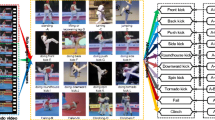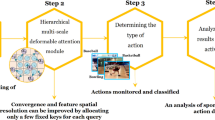Abstract
The deep fusion of sports and machine vision has become a research hot spot in sports video target detection, athlete state recovery and sports promotion. On the basis of in-depth study, it can detect a large number of sports videos, complete the drawing and analysis of human body detection model, and detect and evaluate the posture of corresponding athletes in the video, which can save a lot of costs and maximize the more professional training of athletes. In order to solve the above problems, this paper innovatively completes the automatic language description of sports video based on time-sharing memory algorithm. Its principle is to realize the accurate decomposition of athletes' sports data through the mapping relationship between the corresponding letter sequence and video sequence in time-sharing memory. In order to capture the key posture of athletes' sports video, this paper innovatively proposes an object extraction algorithm based on athletes' skeleton motion enhancement. In practical application, based on the key pose capture, it is necessary to train the depth selection network in time to extract the key pose of the skeleton. Based on this network, it can enhance the key posture of bone information and accurately express its related features. After extracting the actual athlete's bone information, we need to fine-tune the training network to realize the accurate recognition of key features. Based on the above key algorithms, this paper designs a sports video athlete detection system based on deep learning and makes an experimental research on the related sports video. The experimental results show that the detection accuracy of athletes' sports video is improved by nearly 10% compared with the traditional convolution network recognition algorithm, so the algorithm has obvious advantages in recognition accuracy.










Similar content being viewed by others
Explore related subjects
Discover the latest articles, news and stories from top researchers in related subjects.References
Liu Y, Ji Y (2021) Target recognition of sport athletes based on deep learning and convolutional neural network. J Intell Fuzzy Syst 40(2):2253–2263
Thanjavur K, Babul A, Foran B et al (2021) Recurrent neural network-based acute concussion classifier using raw resting state EEG data. Sci Rep 11(1):12353
Wang P, Chi X, Yu Y (2021) The application of deep learning in college students’ sports cognition and health concept. J Intell Fuzzy Syst 11(24):1–13
Chen Y (2021) Sports sequence images based on convolutional neural network. Math Probl Eng 2021(4):1–14
Yamins D, Dicarlo JJ (2016) Using goal-driven deep learning models to understand sensory cortex. Nat Neurosci 19(3):356
Sirinukunwattana K, Shan E, Tsang YW et al (2016) Locality Sensitive Deep Learning for detection and classification of nuclei in routine colon cancer histology images. IEEE Trans Med Imaging 35(5):1196–1206
Thesen S, Heid O, Mueller E et al (2015) Prospective acquisition correction for head motion with image-based tracking for real-time fMRI. Magn Resonan Med 44(3):457–465
Zhu Y, Drangova M, Pelc NJ (2015) Fourier tracking of myocardial motion using cine-PC data. Magn Resonan Med 35(4):471–480
Hungr N, Baumann M, Long JA et al (2012) A 3D ultrasound robotic prostate brachytherapy system with prostate motion tracking. IEEE Trans Rob 28(6):1382–1397
Xióngbiāo Luó a, B M F A , A D D , et al. Development and comparison of new hybrid motion tracking for bronchoscopic navigation. Med Image Anal, 2012, 16( 3):577–596.
Inoue Y, Sakaguchi Y (2014) Periodic change in phase relationship between target and hand motion during visuo-manual tracking task: Behavioral evidence for intermittent control. Hum Mov Sci 33(2):211–226
Stancic I, Ante et al. Design, development and evaluation of optical motion-tracking system based on active white light markers. IET Sci Meas Technol, 2013, 7(4):206–214.
Olesen OV, Paulsen RR, Hojgaard L et al (2012) Motion tracking for medical imaging: a nonvisible structured light tracking approach. Med Imag IEEE Trans 31(1):79–87
Fu J, Chai T, Su CY et al (2013) Motion/force tracking control of nonholonomic mechanical systems via combining cascaded design and backstepping. Automatica 49(12):3682–3686
Ji S, Fan X, Roberts DW et al (2014) Cortical surface shift estimation using stereovision and optical flow motion tracking via projection image registration. Med Image Anal 18(7):1169–1183
Wu J, Wang J, Liu L (2007) Feature extraction via KPCA for classification of gait patterns. Hum Mov Sci 26(3):393–411
Liu Y, Lai S, Wang B et al (2012) Feature-driven motion model-based particle-filter tracking method with abrupt motion handling. Opt Eng 51(4):7203
Wang N, Mo D, Song Z et al (2019) Feature extraction of precession target based on Doppler profile sequences by maximum likelihood estimation. Electr Lett 55(9):554–556
Torheim G, Godtliebsen F, Axelson D et al (2001) Feature extraction and classification of dynamic contrast-enhanced T2*-weighted breast image data. IEEE Trans Med Imag 20(12):1293
Pham D, Arandjelovic O, Venkatesh S (2014) Detection of dynamic background due to swaying movements from motion features. IEEE Trans Image Process 24(1):332–344
Couceiro R, Carvalho P, Paiva RP et al (2014) Detection of motion artifact patterns in photoplethysmographic signals based ontime and period domain analysis. Physiol Meas 35(12):2369–2388
Koh YJ, Lee C, Kim CS (2015) Video stabilization based on feature trajectory augmentation and selection and robust mesh grid warping. IEEE Trans Image Process 24(12):5260–5273
Goldman GH (2013) Doppler-based motion compensation algorithm for focusing the signature of a rotorcraft. J Acoust Soc Am 133(2):688–696
Kim SK, Kang SJ, Wang TS et al (2013) Feature point classification based global motion estimation for video stabilization. IEEE Trans Consum Electron 59(1):267–272
Author information
Authors and Affiliations
Corresponding author
Ethics declarations
Conflict of interest
We declare that there is no conflict of interest.
Additional information
Publisher's Note
Springer Nature remains neutral with regard to jurisdictional claims in published maps and institutional affiliations.
Rights and permissions
About this article
Cite this article
Ren, H. Sports video athlete detection based on deep learning. Neural Comput & Applic 35, 4201–4210 (2023). https://doi.org/10.1007/s00521-022-07077-9
Received:
Accepted:
Published:
Issue Date:
DOI: https://doi.org/10.1007/s00521-022-07077-9




